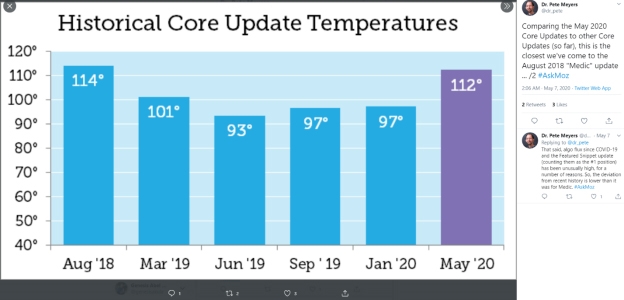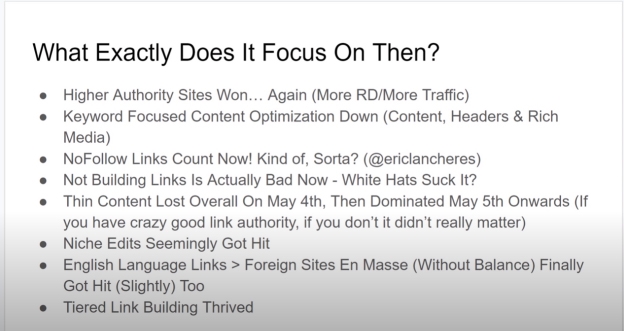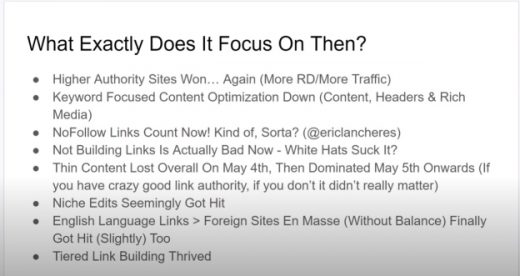Google May 2020 Core Update Analysis
At the height of the pandemic, Google released an update that many webmasters may have found poorly timed. The May 2020 core update is being defined by many as the biggest update of the year and so far, several websites have fallen victim to this update.
Later today, we are releasing a broad core algorithm update, as we do several times per year. It is called the May 2020 Core Update. Our guidance about such updates remains as we’ve covered before. Please see this blog post for more about that:https://t.co/e5ZQUAlt0G
— Google SearchLiaison (@searchliaison) May 4, 2020
This update has seen a lot of volatility with ranking going up and down for many websites. Google though had mentioned that it may take a couple of weeks to settle, so there shouldn’t be any surprises there. Most updates take a while to settle.
So, let’s get down to business and know more about this update.
Who Got Affected by the Update?

Health Sites
It is established that Google takes health very seriously and so it is no surprise that health sites were among those affected by the update. User search intent is very important especially for sites in the YMYL category. While some health-related websites saw an increase in traffic of as much as 30%, there was a number that lost in this update. Health sites may have been affected by this update more than the medic update.
Exact Match Domains Gained
There has been a debate whether it is safe to use exact match domains since Google in the past has penalized such domains. This core update however rewarded these websites. This was not an encouragement for site owners to practice keyword stuffing, it seems more like Google is trying to get websites that let searchers know exactly what to expect and they actually deliver that. If, for example, a website deals in eyeglasses and it uses the domain eyeglasses.com, it makes it easier for Google to recommend it to a user. Such sites saw better ranking following the update.
Local Search Businesses
Aggregator sites and other similar sites that provide links to local businesses saw a surprising shift to the top of the search results. This is probably part of Google’s attempt to ensure that people can find exactly what they are looking for (in this case it can be user’s intent on trying to figure out which one to choose). If a person is looking for a lawyer or real estate agent, they stand a better chance of getting what they want from such sites compared to if they were shown a specific law firm or agent.
Local searches seem to have been integrated into the organic search and this is why these sites saw better ranking.
Simultaneous Multiple Language Sites
Websites that provide multiple language search were also affected by the update. It would seem it is a good idea to be able to appeal to a wider audience and with voice search becoming more common, it is no surprise that one of Google’s updates would target this area. Travel sites seem to have been among those that were affected by this.
Several industries fall under the above categories that were affected by the May update. Notable among them are:
- Real estate
- Health
- Travel
- Books
- Finance
- Pets
- Gaming
- Science
- Society and people
- News media
Our Observations on the Update
Relevancy
With this update, we can observe that Google highly focuses on the ‘most relevant or the best answer’ for the query that the searcher looks for. In other words, this update aims to get users what they want without any delay or obstructions.
Thin Content Lost Out
This was one of the first things recognized after the update. Sites that tend to have content with low word count registered a drop in ranking and traffic. These sites may have been enjoying favorable ranking before the update because they were using internal links and off-page factors to compensate for the thin content, but this did not work in their favor when the update was rolled out.
Not all sites with thin content were affected but the majority were affected negatively. This could imply that there might be some content with low word count which still manages to get the point across. Such sites may be using videos or images to make up for the thin content. This update took a toll on sites that are still stuffing keywords. Such sites saw a dip in the amount of traffic they received after the update was rolled out.
Expertise Articles Are Clear Winners Besides Authority Sites
Google choose to reward articles that had the aspect of real-world expertise and first-hand experience related to the topic the searcher is looking for. Such articles saw their ranking step up due to this update. In fact, authority sites still matter and rank well, but even smaller sites with content that has the element of expertise are witnessing a boost in their rankings due to this update.
Search Intent is Still Important
This is not the first Google update that has targeted search intent. This update seemed to target sites that continue to ignore Google advice to do as much as possible to ensure they are providing what users are looking for. Google seems to recognize the importance of giving users the information they want especially when it comes to health, finance among other vital topics that demand expertise.
No-Follow Links
Google had mentioned earlier in March that they would be implementing a no-follow directive and this update seems to have implemented that. Pages that had high authority no-follow links saw an improvement in their ranking in comparison to those that did not have nofollow links. Google had explained that it would start using nofollow links to better understand the anchor texts and how they relate to the link.
Site with High Referring Domains Gained
Google is always looking to reward sites that do a good job of creating natural backlinks. This update zeroed in on those sites that have many high referring domains and they were rewarded. Such sites can certainly attest that hard work pays. Being able to increase the number of ref domains is a sign that your website can be trusted and your content is worth paying attention to.
Health and Finance are Main Niches Which Got Hit
Google like so many other updates before concentrated on YLYM categories. This core update was not an exception. Health and finance websites experienced the brunt of the updates. Many sites saw a drop in ranking for many different reasons. The main reasons though seemed to rotate around expertise, authority, and relevance (E-A-T).
The COVID-19 pandemic has increased the number of searches for health-related information and Google has been keen to ensure it weeds out misinformation. For instance, health sites that seemed to have unsubstantiated claims of cure for Coronavirus were negatively affected by the update.
Site Speed
Sites that have taken the time to improve their website loading speed saw the benefits of doing that when they experienced a boost in their ranking while those that seemed to ignore this standard SEO practice saw a drop. Having too many images on the site and videos contributed to slower loading speed and that affected their ranking.
Accessibility
This update seemed to have also tried to improve user experience. That is why more accessible sites saw a rise in rank. It makes sense to have users find what they want with ease. No matter what device they are using to access your site, it should be easy to navigate through it.
What Can You Do?
Have you noticed a drop in traffic to your site ever since the update? If so, then you might have some work to do. The first step though would be to study your page analytics to see which particular pages have been affected by the drop in traffic and that would make it easier to make adjustments. You need to know the sites that are ranking good now for your keywords and assess their content among other things.
Edit and Refresh Old Content on Your Website – Demonstrate Real-Life Expertise
Content has always been a big issue for Google. Sites with relevant content that is trustworthy and factual will be rewarded. It is important to refresh your content regularly. This doesn’t mean that you need to churn out content every day. If you have real-life expertise on the topic that the content is dealing with, then do all you can demonstrate it in your content. If not, hire the best expert to create the content that is relevant to the queries of searchers. Also, have your customers share their real-life experiences in the form of an article or encourage them to comment right below the content you’ve posted.
Look at the already existing content and make some changes to it. Update facts and figures to reflect the current situation, go through the content to identify any errors, and sometimes it may be necessary to rewrite content to give it a fresh appeal.
Remove Low Count Thin Content Pages
This update affected sites with thin content. The reason for this is that Google is trying to encourage websites to provide sufficient information to the satisfaction of the users. Thin content leaves a lot unanswered so it needs to be reworked on.
You may have some pages with a low word count that you have not taken note of. Such pages may need to be removed. Alternatively, you can improve on the content so that the word count adds up. Not all pages with low word count lost traffic. Why? They still had sufficient content to answer the questions users have. The use of images and videos at times can make up for a low word count.
No-Follow Links – Clarifying the Intent
Google not only changed the status of nofollow link from a commandment to a hint but even introduced two new attributes for this category that includes ‘sponsored’ links and ‘user-generated-content’ links. You need to implement these unique attributes to links on your website that fall under nofollow category, so Google can better understand the nature of links on your site. Check out this rel tags guide by Google to start implementing it on your website, so it better understands your site that leads to better ranking.
Backlinks from High Referring Domains
Earning backlinks from high referring domains whether they are online publications relevant to your industry or news websites among others can make a huge difference. You can create a research paper or content that is worthy of linking to and find high domains that will be interested in referring to these pages. Ensure you earn them naturally and they shouldn’t look like they are paid for as Google is getting very good at discerning them.
Health (Medical) and Finance Websites Need to Improve on E-A-T Aspect
If you are in the health, medical, and finance industry, then your website needs some serious work to do. The first thing to do is to audit the website’s content frequently. Review the content regularly and make any changes if necessary, for instance, it could be a change in tax rates or a new medicine for an existing condition. Finance sites whether it relates to personal loans or repairing credit score need to build on the principles of E-A-T to gain better position in SERP. These sites can have a great impact on the searcher’s financial well-being and stability and Google takes it seriously just like it does for sites related to medical and physical health. You need to ensure the content authored on your website are by experts in the industry with relevant credentials, accreditations, and experience.
Also, your company’s media citations, social media profiles, third party reviews, among other things must display trustworthiness as Google’s algorithms do an extensive reputation search. So deal with any negative press swiftly and build trust in your brand.
Focus on Your Website’s Speed
As discussed in the above observation, you need to speed up your website, visitors generally leave a site if it takes more than 3-4 seconds to load. So get in touch with your web developer and get rid of any unwanted graphics, images, and videos that take time to load. Also, decrease server response time, mix and minify files and do a compression audit among other things.
Make Your Site More Accessible
Google has a guide to improve accessibility of your site. It is recommended that you carry out an accessibility audit of all your pages. You can use the chrome development tool to perform the audit. This tool is particularly for developers. The accessibility audit will reveal what areas you need to improve.
Watch the Competition
The competition can be a guide for you to determine what to do. If your competition is one of the winners in this update, you should find out what they are doing better than you and probably follow the strategy. Make use of tools that can show you what is going on with the competition.
Be Patient
Every SEO thought leader in the industry got their unique insights and interpretations on this update and you need to be patient and let the dust settle. Here’s a screenshot of a video by Charles Floate about his analysis on this May 4th core update:

If you have gone through some of the information Google provides about core updates, you may have noted that if you are negatively affected by a core update, you will need to wait for the next core update to recover. This doesn’t mean sit back and do nothing. The actions you take now will be rewarded in the next core update so you will need to be patient for another 3 to 4 months before you see improvements.
Final Thoughts
The timing of the update may have played a part in determining which industries recorded less traffic to their sites. It is possible that even without doing anything, some sites will regain their positions in the SERP once the situation changes and people resume their normal activity. It is best that sites do not rush to make drastic changes based on early observations. Above all, go through Google’s Search Quality Evaluator Guidelines and Google’s Core Updates blog to see if your website is on the low- or high-quality side of value.
Digital & Social Articles on Business 2 Community
(9)


